4.2 Prokaryotic Diversity
Mary Ann Clark; Jung Choi; and Matthew Douglas
Learning Objectives
By the end of this section, you will be able to do the following:
- Describe the evolutionary history of prokaryotes
- Discuss the distinguishing features of extremophiles
- Explain why it is difficult to culture prokaryotes
Prokaryotes are ubiquitous. They cover every imaginable surface where there is sufficient moisture, and they also live on and inside virtually all other living things. In the typical human body, prokaryotic cells outnumber human body cells by about ten to one. They comprise the majority of living things in all ecosystems. Some prokaryotes thrive in environments that are inhospitable for most living things. Prokaryotes recycle nutrients—essential substances (such as carbon and nitrogen)—and they drive the evolution of new ecosystems, some of which are natural and others man-made. Prokaryotes have been on Earth since long before multicellular life appeared. Indeed, eukaryotic cells are thought to be the descendants of ancient prokaryotic communities.
Prokaryotes, the First Inhabitants of Earth
When and where did cellular life begin? What were the conditions on Earth when life began? We now know that prokaryotes were likely the first forms of cellular life on Earth, and they existed for billions of years before plants and animals appeared. The Earth and its moon are dated at about 4.54 billion years in age. This estimate is based on evidence from radiometric dating of meteorite material together with other substrate material from Earth and the moon. Early Earth had a very different atmosphere (contained less molecular oxygen) than it does today and was subjected to strong solar radiation; thus, the first organisms probably would have flourished where they were more protected, such as in the deep ocean or far beneath the surface of the Earth. Strong volcanic activity was common on Earth at this time, so it is likely that these first organisms—the first prokaryotes—were adapted to very high temperatures. Because early Earth was prone to geological upheaval and volcanic eruption and was subject to bombardment by mutagenic radiation from the sun, the first organisms were prokaryotes that must have withstood these harsh conditions.
Microbial Mats
Microbial mats or large biofilms may represent the earliest forms of prokaryotic life on Earth; there is fossil evidence of their presence starting about 3.5 billion years ago. It is remarkable that cellular life appeared on Earth only a billion years after the Earth itself formed, suggesting that pre-cellular “life” that could replicate itself had evolved much earlier. A microbial mat is a multi-layered sheet of prokaryotes that includes mostly bacteria, but also archaeans. Microbial mats are only a few centimeters thick, and they typically grow where different types of materials interface, mostly on moist surfaces. The various types of prokaryotes that comprise them carry out different metabolic pathways, and that is the reason for their various colors. Prokaryotes in a microbial mat are held together by a glue-like sticky substance that they secrete called extracellular matrix.
The first microbial mats likely obtained their energy from chemicals found near hydrothermal vents. A hydrothermal vent is a breakage or fissure in the Earth’s surface that releases geothermally heated water. With the evolution of photosynthesis about three billion years ago, some prokaryotes in microbial mats came to use a more widely available energy source—sunlight—whereas others were still dependent on chemicals from hydrothermal vents for energy and food.
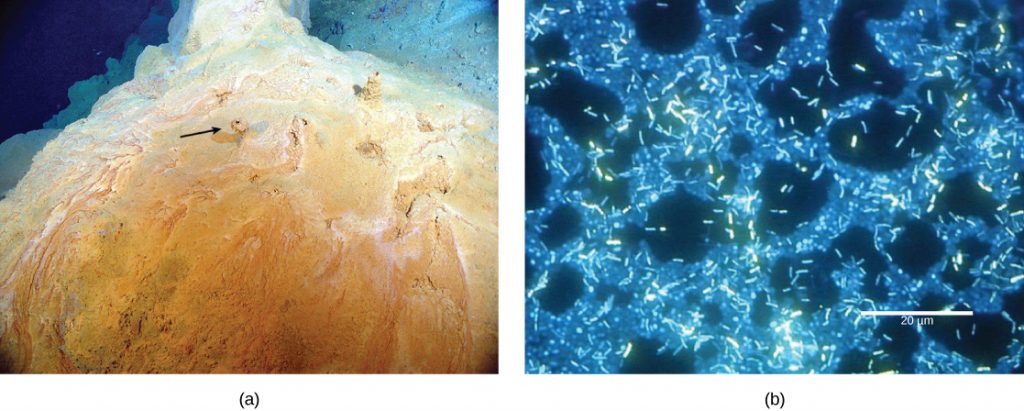
Stromatolites
Fossilized microbial mats represent the earliest record of life on Earth. A stromatolite is a sedimentary structure formed when minerals are precipitated out of water by prokaryotes in a microbial mat. Stromatolites form layered rocks made of carbonate or silicate. Although most stromatolites are artifacts from the past, there are places on Earth where stromatolites are still forming. For example, growing stromatolites have been found in the Anza-Borrego Desert State Park in San Diego County, California.
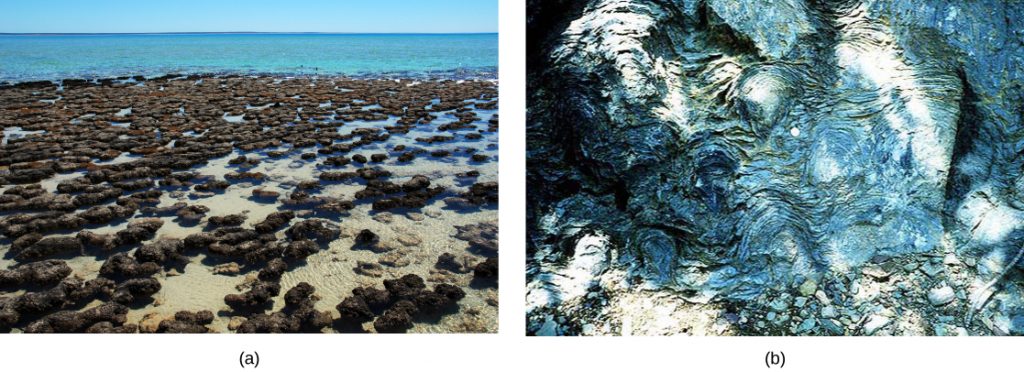
The Ancient Atmosphere
Evidence indicates that during the first two billion years of Earth’s existence, the atmosphere was anoxic, meaning that there was no molecular oxygen. Therefore, only those organisms that can grow without oxygen—anaerobic organisms—were able to live. Autotrophic organisms that convert solar energy into chemical energy are called phototrophs, and they appeared within one billion years of the formation of Earth. Then, cyanobacteria, also known as “blue-green algae,” evolved from these simple phototrophs at least one billion years later. It was the ancestral cyanobacteria that began the “oxygenation” of the atmosphere: Increased atmospheric oxygen allowed the evolution of more efficient O2-utilizing catabolic pathways. It also opened up the land to increased colonization, because some O2 is converted into O3 (ozone) and ozone effectively absorbs the ultraviolet light that could have otherwise caused lethal mutations in DNA. The current evidence suggests that the increase in O2 concentrations allowed for the evolution of other life forms.

Microbes Are Adaptable: Life in Moderate and Extreme Environments
Some organisms have developed strategies that allow them to survive harsh conditions. Almost all prokaryotes have a cell wall, a protective structure that allows them to survive in both hypertonic and hypotonic aqueous conditions. Some soil bacteria are able to form endospores that resist heat and drought, thereby allowing the organism to survive until favorable conditions recur. These adaptations, along with others, allow bacteria to remain the most abundant life form in all terrestrial and aquatic ecosystems.
Prokaryotes thrive in a vast array of environments: Some grow in conditions that would seem very normal to us, whereas others are able to thrive and grow under conditions that would kill a plant or an animal. Bacteria and archaea that are adapted to grow under extreme conditions are called extremophiles, meaning “lovers of extremes.” Extremophiles have been found in all kinds of environments: the depths of the oceans, hot springs, the Arctic and the Antarctic, very dry places, deep inside Earth, harsh chemical environments, and high radiation environments, just to mention a few. Because they have specialized adaptations that allow them to live in extreme conditions, many extremophiles cannot survive in moderate environments. There are many different groups of extremophiles: They are identified based on the conditions in which they grow best, and several habitats are extreme in multiple ways. For example, a soda lake is both salty and alkaline, so organisms that live in a soda lake must be both alkaliphiles and halophiles. Other extremophiles, like radioresistant organisms, do not prefer an extreme environment (in this case, one with high levels of radiation), but have adapted to survive in it. Organisms like these give us a better understanding of prokaryotic diversity and open up the possibility of finding new prokaryotic species that may lead to the discovery of new therapeutic drugs or have industrial applications.
| Extremophiles and Their Preferred Conditions | |
|---|---|
| Extremophile | Conditions for Optimal Growth |
| Acidophiles | pH 3 or below |
| Alkaliphiles | pH 9 or above |
| Thermophiles | Temperature 60–80 °C (140–176 °F) |
| Hyperthermophiles | Temperature 80–122 °C (176–250 °F) |
| Psychrophiles | Temperature of -15–10 °C (5–50 °F) or lower |
| Halophiles | Salt concentration of at least 0.2 M |
| Osmophiles | High sugar concentration |
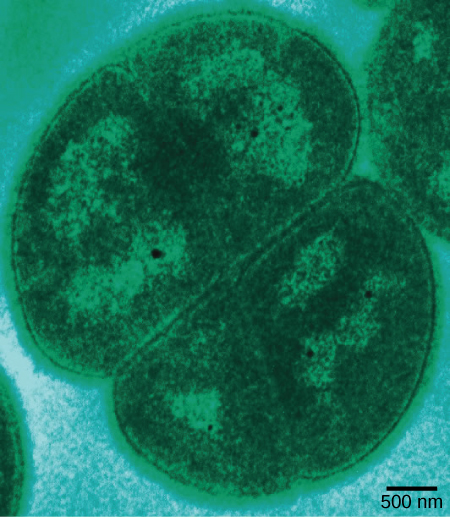
Prokaryotes in the Dead Sea
One example of a very harsh environment is the Dead Sea, a hypersaline basin that is located between Jordan and Israel. Hypersaline environments are essentially concentrated seawater. In the Dead Sea, the sodium concentration is 10 times higher than that of seawater, and the water contains high levels of magnesium (about 40 times higher than in seawater) that would be toxic to most living things. Iron, calcium, and magnesium, elements that form divalent ions (Fe2+, Ca2+, and Mg2+), produce what is commonly referred to as “hard” water. Taken together, the high concentration of divalent cations, the acidic pH (6.0), and the intense solar radiation flux make the Dead Sea a unique, and uniquely hostile, ecosystem.[1]
What sort of prokaryotes do we find in the Dead Sea? The extremely salt-tolerant bacterial mats include Halobacterium, Haloferax volcanii (which is found in other locations, not only the Dead Sea), Halorubrum sodomense, and Halobaculum gomorrense, and the archaean Haloarcula marismortui, among others.
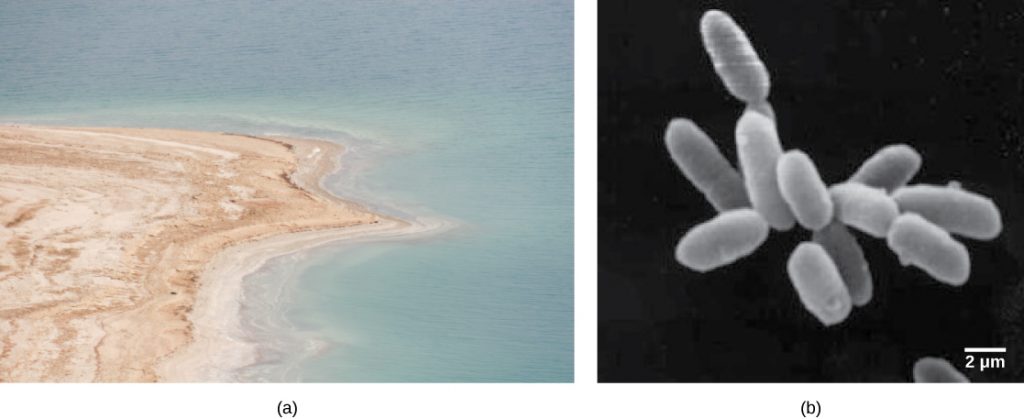
Unculturable Prokaryotes and the Viable-but-Non-Culturable State
The process of culturing bacteria is complex and is one of the greatest discoveries of modern science. German physician Robert Koch is credited with discovering the techniques for pure culture, including staining and using growth media. Microbiologists typically grow prokaryotes in the laboratory using an appropriate culture medium containing all the nutrients needed by the target organism. The medium can be liquid, broth, or solid. After an incubation time at the right temperature, there should be evidence of microbial growth. Koch’s assistant Julius Petri invented the Petri dish, whose use persists in today’s laboratories. Koch worked primarily with the Mycobacterium tuberculosis bacterium that causes tuberculosis and developed guidelines, called Koch’s postulates, to identify the organisms responsible for specific diseases. Koch’s postulates continue to be widely used in the medical community. Koch’s postulates include that an organism can be identified as the cause of disease when it is present in all infected samples and absent in all healthy samples, and it is able to reproduce the infection after being cultured multiple times. Today, cultures remain a primary diagnostic tool in medicine and other areas of molecular biology.
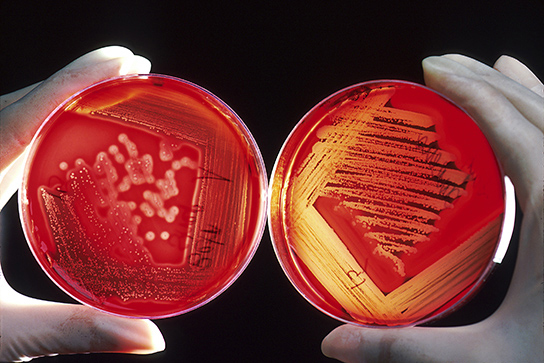
Koch’s postulates can be fully applied only to organisms that can be isolated and cultured. Some prokaryotes, however, cannot grow in a laboratory setting. In fact, over 99 percent of bacteria and archaea are unculturable. For the most part, this is due to a lack of knowledge as to what to feed these organisms and how to grow them; they may have special requirements for growth that remain unknown to scientists, such as needing specific micronutrients, pH, temperature, pressure, co-factors, or co-metabolites. Some bacteria cannot be cultured because they are obligate intracellular parasites and cannot be grown outside a host cell.
In other cases, culturable organisms become unculturable under stressful conditions, even though the same organism could be cultured previously. Those organisms that cannot be cultured but are not dead are in a viable-but-non-culturable (VBNC) state. The VBNC state occurs when prokaryotes respond to environmental stressors by entering a dormant state that allows their survival. The criteria for entering into the VBNC state are not completely understood. In a process called resuscitation, the prokaryote can go back to “normal” life when environmental conditions improve.
Is the VBNC state an unusual way of living for prokaryotes? In fact, most of the prokaryotes living in the soil or in oceanic waters are non-culturable. It has been said that only a small fraction, perhaps one percent, of prokaryotes can be cultured under laboratory conditions. If these organisms are non-culturable, then how is it known whether they are present and alive? Microbiologists use molecular techniques, such as the polymerase chain reaction (PCR), to amplify selected portions of DNA of prokaryotes, e.g., 16S rRNA genes, demonstrating their existence. (Recall that PCR can make billions of copies of a DNA segment in a process called amplification.)
The Ecology of Biofilms
Some prokaryotes may be unculturable because they require the presence of other prokaryotic species. Until a couple of decades ago, microbiologists used to think of prokaryotes as isolated entities living apart. This model, however, does not reflect the true ecology of prokaryotes, most of which prefer to live in communities where they can interact. As we have seen, a biofilm is a microbial community held together in a gummy-textured matrix that consists primarily of polysaccharides secreted by the organisms, together with some proteins and nucleic acids. Biofilms typically grow attached to surfaces. Some of the best-studied biofilms are composed of prokaryotes, although fungal biofilms have also been described, as well as some composed of a mixture of fungi and bacteria.
Biofilms are present almost everywhere: they can cause the clogging of pipes and readily colonize surfaces in industrial settings. In recent, large-scale outbreaks of bacterial contamination of food, biofilms have played a major role. They also colonize household surfaces, such as kitchen counters, cutting boards, sinks, and toilets, as well as places on the human body, such as the surfaces of our teeth.
Interactions among the organisms that populate a biofilm, together with their protective exopolysaccharidic (EPS) environment, make these communities more robust than free-living, or planktonic, prokaryotes. The sticky substance that holds bacteria together also excludes most antibiotics and disinfectants, making biofilm bacteria hardier than their planktonic counterparts. Overall, biofilms are very difficult to destroy because they are resistant to many common forms of sterilization.
Visual Connection
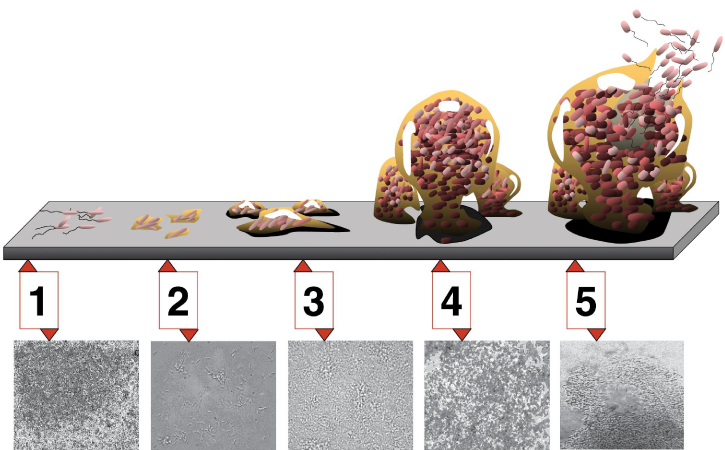
Section Summary
Prokaryotes existed for billions of years before plants and animals appeared. Hot springs and hydrothermal vents may have been the environments in which life began. Microbial mats are thought to represent the earliest forms of life on Earth. A microbial mat is a multi-layered sheet of prokaryotes that grows at interfaces between different types of material, mostly on moist surfaces. Fossilized microbial mats are called stromatolites and consist of laminated organo-sedimentary structures formed by precipitation of minerals by prokaryotes. They represent the earliest fossil record of life on Earth.
During the first two billion years, the atmosphere was anoxic, and only anaerobic organisms were able to live. Cyanobacteria evolved from early phototrophs and began the oxygenation of the atmosphere. The increase in oxygen concentration allowed the evolution of other life forms.
Bacteria and archaea grow in virtually every environment. Those that survive under extreme conditions are called extremophiles (extreme lovers). Some prokaryotes cannot grow in a laboratory setting, but they are not dead. They are in the viable-but-non-culturable (VBNC) state. The VBNC state occurs when prokaryotes enter a dormant state in response to environmental stressors. Most prokaryotes are colonial and prefer to live in communities where interactions take place. A biofilm is a microbial community held together in a gummy-textured matrix.
Review Questions
Critical Thinking Questions
Glossary
- acidophile
- organism with optimal growth pH of three or below
- alkaliphile
- organism with optimal growth pH of nine or above
- anaerobic
- refers to organisms that grow without oxygen
- anoxic
- without oxygen
- biofilm
- microbial community that is held together by a gummy-textured matrix
- cyanobacteria
- bacteria that evolved from early phototrophs and oxygenated the atmosphere; also known as blue-green algae
- extremophile
- organism that grows under extreme or harsh conditions
- halophile
- organism that requires a salt concentration of at least 0.2 M
- hydrothermal vent
- fissure in Earth’s surface that releases geothermally heated water
- hyperthermophile
- organism that grows at temperatures between 80–122 °C
- microbial mat
- multi-layered sheet of prokaryotes that may include bacteria and archaea
- nutrient
- essential substances for growth, such as carbon and nitrogen
- osmophile
- organism that grows in a high sugar concentration
- phototroph
- organism that is able to make its own food by converting solar energy to chemical energy
- psychrophile
- organism that grows at temperatures of -15 °C or lower
- radioresistant
- organism that grows in high levels of radiation
- resuscitation
- process by which prokaryotes that are in the VBNC state return to viability
- stromatolite
- layered sedimentary structure formed by precipitation of minerals by prokaryotes in microbial mats
- thermophile
- organism that lives at temperatures between 60–80 °C
- viable-but-non-culturable (VBNC) state
- survival mechanism of bacteria facing environmental stress conditions
Footnotes
- Bodaker, I, Itai, S, Suzuki, MT, Feingersch, R, Rosenberg, M, Maguire, ME, Shimshon, B, and others. Comparative community genomics in the Dead Sea: An increasingly extreme environment. The ISME Journal 4 (2010): 399–407, doi:10.1038/ismej.2009.141ALERTS: Underlined text. published online 24 December 2009. ↵

